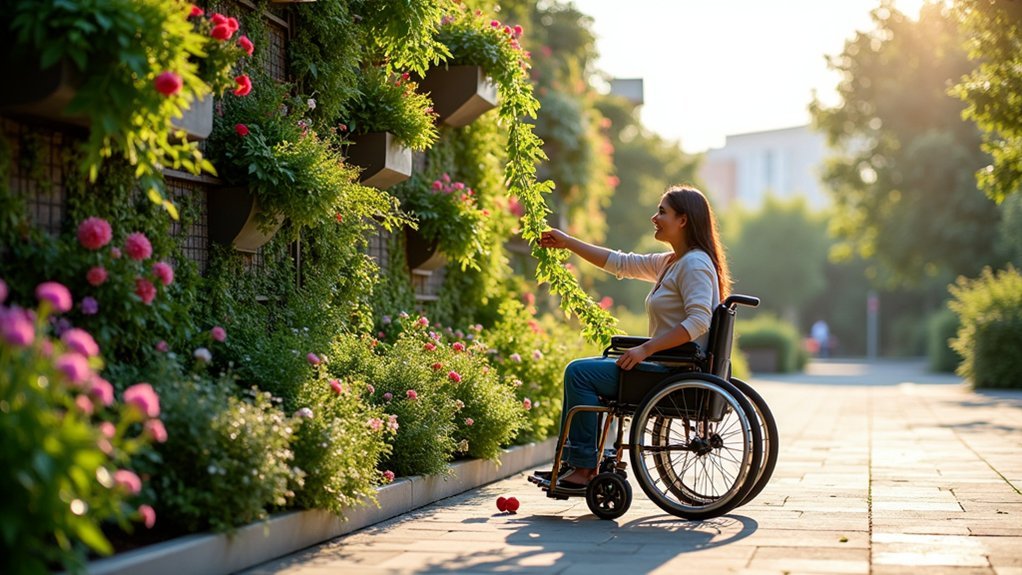Vertical gardens offer you accessibility benefits that traditional gardening lacks. You’ll appreciate how they elevate plants to your ideal reach zone (28-34 inches high), eliminate navigation obstacles, and reduce strain with their limited depth design. The therapeutic benefits include stress reduction and improved mental health while you tend to plants. Self-watering systems and wheeled containers enhance your gardening independence. Discover how these space-efficient solutions can transform your gardening experience while accommodating your mobility needs.
The Perfect Height: Designing Vertical Gardens for Wheelchair Access

When designing vertical gardens for wheelchair users, height becomes the critical factor that determines accessibility and enjoyment. The ideal vertical garden should stand between 28 and 34 inches tall—low enough to see and reach comfortably from a seated position, yet high enough to prevent excessive bending.
Accessibility in vertical gardening begins with height—28 to 34 inches creates the perfect balance for seated gardeners.
You’ll want to take into account two main approaches: parallel access, where you position your wheelchair alongside the garden (keeping plants within 24 inches of reach), or forward approach, where your wheelchair rolls underneath portions of the garden. Installing non-slip decking around your vertical garden will ensure safety while navigating the space.
For this second option, guarantee at least 27 inches of clearance height and 30 inches of width beneath the structure.
Remember to maintain consistent heights throughout your garden elements and limit bed depth to about 24 inches to prevent strain during reaching.
Space-Saving Solutions for Limited Mobility Gardeners
While traditional gardens sprawl across yards demanding constant bending and kneeling, vertical gardens offer wheelchair users an elegant space-saving alternative that transforms gardening from frustration to joy. You’ll find modular systems can be customized to your specific reach requirements and mobility needs. Ergonomic tools with comfortable grips significantly enhance the vertical gardening experience for wheelchair users.
| Space-Saving Feature | Benefit for Wheelchair Users |
|---|---|
| Wall-mounted planters | Eliminates floor navigation obstacles |
| Stacked pot systems | Creates multiple growing zones within reach |
| Columnar garden towers | Maximizes planting density in minimal footprint |
| Hanging planters | Provides varied heights without bending |
Select compact or dwarf plant varieties to reduce maintenance frequency. Group plants with similar water needs together to streamline care routines. Consider lightweight containers that you can easily reposition, paired with extended-handle tools for comfortable tending without strain.
Therapeutic Benefits of Tending to Vertical Plant Displays

Beyond the practical advantages of accessibility, vertical gardens offer wheelchair users profound therapeutic benefits that transform everyday gardening into healing rituals.
You’ll experience reduced stress levels and improved mental health as you engage with your vertical display in a calming environment. Tending to plants lowers cortisol levels while boosting serotonin production, effectively combating depression and anxiety. The vertical garden design can absorb ambient noise levels to create a more peaceful environment for therapeutic gardening.
You’ll notice improved concentration and a sense of accomplishment as you nurture your garden. The physical health benefits are equally impressive—your plants purify the air, increase oxygen levels, and help manage humidity, contributing to better respiratory and cardiovascular health.
The mindfulness required for gardening tasks provides a meditative escape, while the social aspects of sharing your garden create opportunities for meaningful connection and community building.
Easy Maintenance Features That Empower Independent Gardening
Independent gardening becomes achievable for wheelchair users through thoughtfully designed maintenance features that minimize physical strain.
You’ll find drip irrigation systems and self-watering planters particularly valuable, as they reduce the need for frequent manual watering.
Long-handled, adapted tools allow you to tend to your vertical garden from a seated position, eliminating uncomfortable reaching or bending.
Consider installing pulley systems for hanging baskets, which let you easily adjust plant heights for maintenance.
Container gardens on wheels or caddies provide flexibility to rearrange your space as needed.
For maximum independence, select low-maintenance plants that require minimal care, and organize your vertical garden with a logical layout that keeps everything within comfortable reach. Install accessible pathways around your vertical garden setup to ensure easy movement and prevent safety hazards.
These thoughtful adaptations transform gardening from a challenging activity into an accessible, enjoyable pursuit.
Customization Options for Various Abilities and Garden Goals

Customizing vertical gardens empowers wheelchair users to create spaces perfectly suited to their unique abilities and gardening aspirations.
You’ll find numerous options to match your specific needs, whether you’re looking for aesthetic appeal or an edible harvest.
Table-style beds allow your wheelchair to roll underneath, providing comfortable lap-level access. Consider beds 24-30 inches high with 2-4 foot width variations based on your reach. Accessible planters with ergonomic tool access improve comfort and reduce strain during gardening sessions.
Accessible table-style beds provide essential lap-level gardening, with customizable heights and widths to match your individual reach requirements.
For maximum accessibility, install sitting ledges and guarantee 4-5 foot pathways between garden areas.
Your vertical garden can serve multiple purposes—grow climbing vegetables like peas and cucumbers for fresh produce, or create sensory experiences with aromatic plants and water features.
Incorporate smart irrigation systems to reduce maintenance demands, and select materials like wood or plastic timbers that best suit your climate and preferences.
Frequently Asked Questions
What Soil Mixtures Work Best for Wheelchair-Accessible Vertical Gardens?
You’ll get the best results with a well-draining mix of compost, peat moss, and perlite or vermiculite. This combination provides proper drainage, nutrient balance, and moisture retention without becoming too heavy.
How Do Vertical Gardens Perform in Extreme Weather Conditions?
Vertical gardens withstand extreme weather when properly designed. You’ll need robust structures for wind and rain, drought-resistant plants for heat, and efficient irrigation systems. They’ll even reduce ambient temperatures by up to 3°C during heatwaves.
Can Automated Watering Systems Be Integrated With Vertical Gardens?
Yes, you can integrate automated watering systems with vertical gardens using drip irrigation, smart controllers, and moisture sensors. They’ll conserve water, simplify maintenance, and guarantee your plants receive consistent hydration even when you’re away.
What Are the Initial Costs Compared to Traditional Gardening Methods?
You’ll face higher initial costs for vertical gardens, typically $800-1200 CAD versus $400-600 CAD for traditional setups. This includes specialized structures and irrigation systems that traditional methods don’t require.
Which Plants Should Be Avoided in Wheelchair-Accessible Vertical Gardens?
You should avoid toxic plants like oleander and foxglove, thorny species like cacti and thistle, allergy-triggering plants like ragweed, invasive species, and plants with sharp spines such as agave in wheelchair-accessible vertical gardens.
In Summary
Vertical gardens aren’t just beautiful—they’re game changers for your gardening independence. You’ll find them perfectly positioned at your reach, conserving precious space while offering therapeutic benefits daily. They’re easily maintained on your terms, with customization options that adapt to your specific needs. Whether you’re a seasoned gardener or just starting out, vertical gardens literally elevate the experience, making nature accessible right at your fingertips.





Leave a Reply